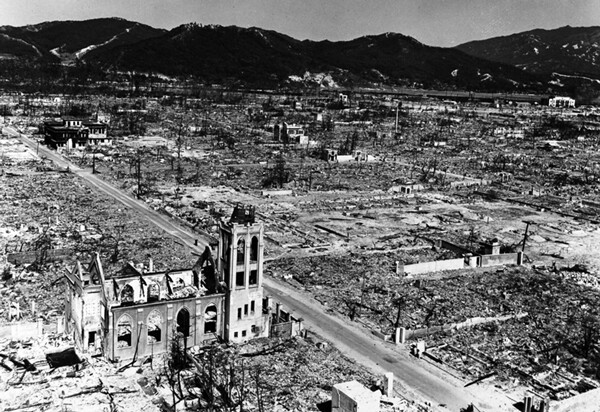News & Articles
Browse all content by date.

Forty years ago I started reading legal arguments against nuclear weapons. With an atomic ignoramus in the White House asking “Why can’t we use ‘em?,” Bill Durland, Dave McReynolds, Peter Weiss, Jackie Cabasso, Francis Boyle, John Burroughs and others have been explaining why for decades.
Radiation is “analogous” to gas, and attacks that are analogous to gas warfare are banned by the 1925 Geneva Gas Protocol. The 1907 Hague Regulations prohibit the use of poison or poisoned weapons, and radioactive fallout is poisonous to say the least. Indiscriminate destruction was forbidden by the 1945 Geneva Conventions. The 1945 Nuremberg Charter (written by US judges) outlaws planning and preparation of massacres -- a monumental change in treaty law, since it implicates nuclear war planners before nuclear weapons cause massacres.
In 1961, the United Nations General Assembly adopted Resolution 1653, “Recalling that the use of weapons of mass destruction, causing unnecessary human suffering, was in the past prohibited, as being contrary to the laws of humanity and to the principles of international law, by international declarations and binding agreements …to which the majority of nations are still parties.” The UN resolution:
“Declares that: a) The use of nuclear and thermo-nuclear weapons is … a direct violation of the Charter of the United Nations;
b) The use of nuclear and thermo- nuclear weapons would exceed even the scope of war and cause indiscriminate suffering and destruction to [hu]mankind and civilization and, as such, is contrary to the rules of international law and to the laws of humanity;
c) The use of nuclear and thermo-nuclear weapons is a war directed not against an enemy or enemies alone but also against [hu]mankind in general, since the peoples of the world not involved in such a war will be subjected to all the evils generated by the use of such weapons;
d) Any State using nuclear and thermo-nuclear weapons is to be considered as …acting contrary to the laws of humanity and as committing a crime against [hu]mankind and civilization; and
Requests that the Secretary-General to consult the Governments of Member States to ascertain their view on the possibility of convening a special conference for signing a convention on the prohibition of the use of nuclear and thermo-nuclear weapons for war purposes...”
Member states must have said, “Let’s wait,” as that was 56 years ago. In 1968, the Non-Proliferation Treaty obligated the US and the other signers to “pursue negotiations in good faith on effective measures relating to cessation of the nuclear arms race at an early date and to nuclear disarmament.” Forty-nine years later, “at an early date” sort of sticks in the throat.
In 1996, a global movement pushed the International Court of Justice or World Court to hear arguments from UN Member States on the legality of the threat or use of nuclear weapons. The Court concluded that “the threat of use of nuclear weapons would generally be contrary to the rules of international law…” The Court also reminded the world that the Nonproliferation Treaty requires not just good faith negotiations, but that the Members “bring to a conclusion negotiations leading to nuclear disarmament in all its aspects under strict and effective international control.”
Finally, the “early date” has arrived, and last March at least 130 countries joined the long-sought-after negotiations for a treaty ban. Then, on May 22, 2017, the “Draft Convention on the Prohibition of Nuclear Weapons” was calmly delivered to the United Nations for consideration this July. Its language is clear, compelling, and a little awe-inspiring. The preamble says in part:
Deeply concerned about the catastrophic humanitarian consequences that would result from any use of nuclear weapons and the consequent need to make every effort to ensure that nuclear weapons are never used again under any circumstances,
Cognizant that the catastrophic consequences of nuclear weapons transcend national borders, pose grave implications for human survival, the environment, socioeconomic development, the global economy, food security and for the health of future generations, and of the disproportionate impact of ionizing radiation on maternal health and on girls, …
Affirming that there exists an obligation to pursue in good faith and bring to a conclusion negotiations leading to nuclear disarmament in all its aspects under strict and effective international control…
The Articles declare that “Each State Party undertakes never under any circumstances to:
a) Develop, produce, manufacture, otherwise acquire, possess or stockpile nuclear weapons or other nuclear explosive devices; b) Transfer to any recipient whatsoever nuclear weapons or other nuclear explosive devices or control over such weapons or explosive devices directly, or indirectly; c) Receive the transfer or control over nuclear weapons or other nuclear explosive devices directly, or indirectly; d) Use nuclear weapons; e) Carry out any nuclear weapon test explosion or any other nuclear explosion…
There are lengthy sections about verifiable compliance and enforcement, all to be finalized this summer.
Beatrice Fihn, the Director of the International Campaign to Abolish Nuclear Weapons, celebrated the news this way: “The release of a draft treaty to ban nuclear weapons is a milestone in the decades-long effort to ban these indiscriminate weapons of mass destruction because of their inhumane and catastrophic impacts. Once adopted, the treaty will constitute an important step toward their eventual elimination.”
How about a toast!
| Tweet |

